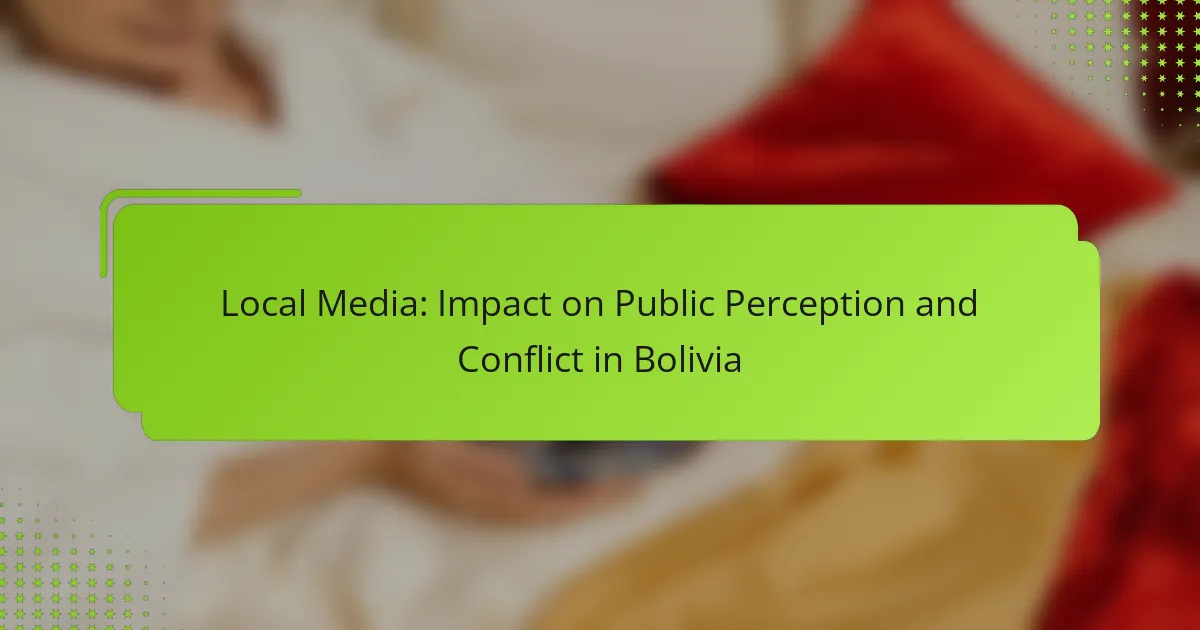Local media in Bolivia plays a crucial role in shaping public perception by framing issues and highlighting specific narratives that influence discourse around political and social events. Its selective reporting and sensationalism can exacerbate conflicts, affecting social cohesion and community responses to crises. By prioritizing accuracy and fairness, local media has the potential to foster trust and promote informed discussions among the public.
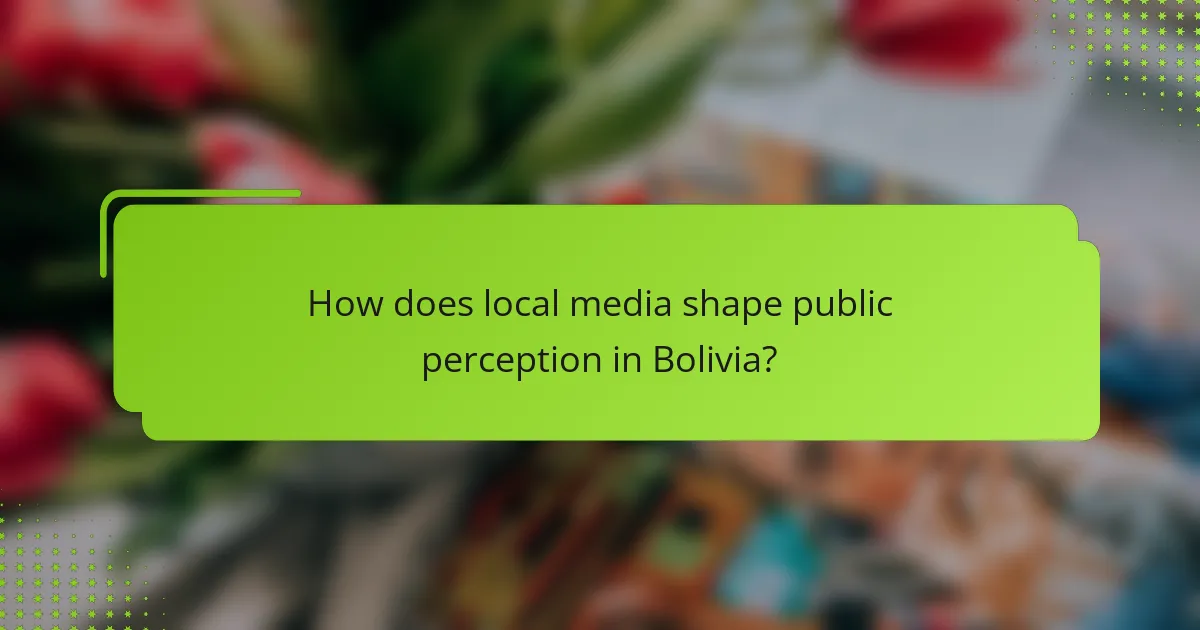
How does local media shape public perception in Bolivia?
Local media in Bolivia significantly influences public perception by framing issues, highlighting specific narratives, and shaping the discourse around political and social events. Through news coverage and community engagement, local media outlets can sway public opinion and impact the overall understanding of critical issues.
Influence of news coverage on public opinion
News coverage in Bolivia plays a crucial role in shaping public opinion by selecting which stories to highlight and how to present them. For instance, extensive coverage of political protests can either galvanize support or incite opposition, depending on the framing used. The choice of language, imagery, and focus can lead to differing perceptions among the public.
Moreover, local media often reflects the interests of specific political groups or business entities, which can skew public understanding. Audiences may develop biases based on the predominant narratives presented, leading to polarized views on important issues.
Role of social media in shaping narratives
Social media has become a powerful tool in Bolivia for shaping narratives and influencing public perception. Platforms like Facebook and Twitter allow for rapid dissemination of information, enabling users to share news articles, opinions, and personal experiences. This can amplify certain viewpoints while marginalizing others, creating echo chambers that reinforce existing beliefs.
Additionally, social media can facilitate grassroots movements and mobilize public opinion quickly. However, the spread of misinformation is a significant concern, as unverified claims can lead to confusion and conflict among the populace.
Impact of local journalism on community engagement
Local journalism fosters community engagement by providing a platform for residents to voice their concerns and participate in civic discussions. By covering local events and issues, journalists can empower citizens to take action and hold authorities accountable. This engagement is vital for a healthy democracy, as it encourages informed participation in public life.
Furthermore, local media often collaborates with community organizations to address specific issues, creating a feedback loop that enhances public awareness and involvement. However, challenges such as limited resources and political pressures can hinder the effectiveness of local journalism in fulfilling this role.
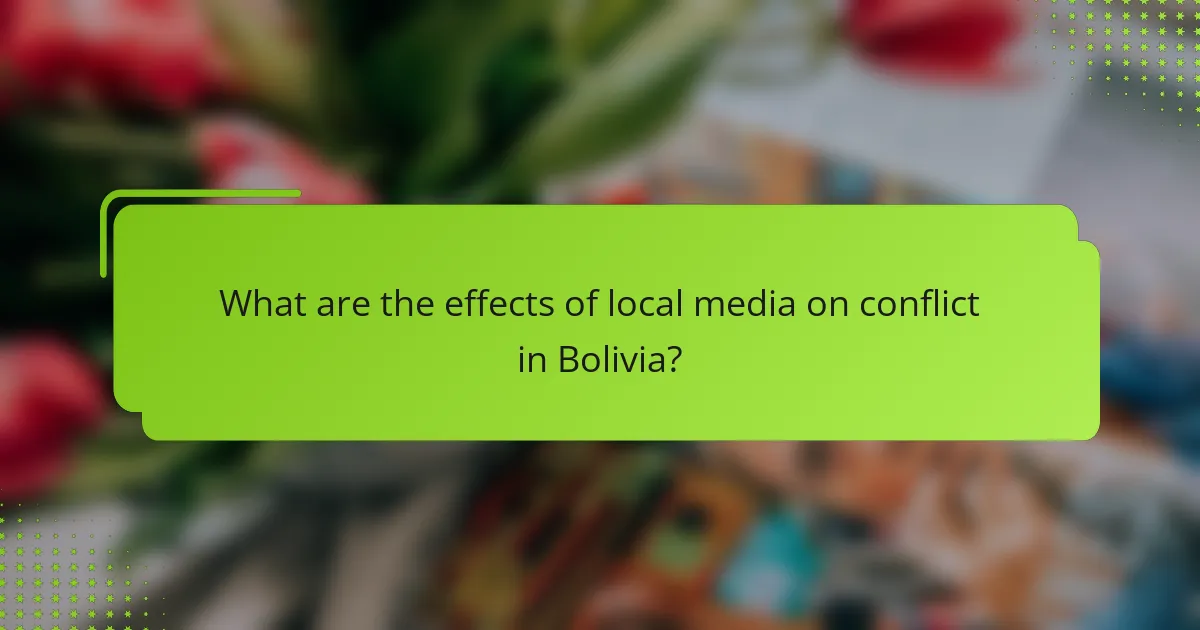
What are the effects of local media on conflict in Bolivia?
Local media significantly influences public perception and can exacerbate conflicts in Bolivia by shaping narratives and framing issues. Through selective reporting and sensationalism, media outlets can escalate tensions among communities, impacting social cohesion and public response to crises.
Media’s role in escalating tensions
Local media often plays a critical role in escalating tensions during conflicts by amplifying divisive narratives. By focusing on sensational stories or highlighting confrontations, media can provoke emotional reactions and deepen societal divides. This can lead to increased polarization, where different groups perceive each other with heightened suspicion and hostility.
Moreover, the speed at which information spreads through local media can contribute to rapid escalation. In a country like Bolivia, where social media is widely used, misinformation can circulate quickly, leading to misunderstandings and conflicts that might have otherwise been resolved peacefully.
Case studies of media influence during protests
One notable case is the 2019 protests in Bolivia following the controversial presidential elections. Local media coverage varied significantly, with some outlets portraying the protests as legitimate expressions of dissent, while others framed them as violent uprisings. This divergence in reporting influenced public perception and the government’s response, leading to increased tensions and clashes.
Another example occurred during the 2003 Gas War, where media coverage played a pivotal role in shaping public opinion against government policies. The portrayal of protestors as defenders of national resources galvanized support for the movement, demonstrating how local media can mobilize public sentiment and impact the trajectory of social movements.
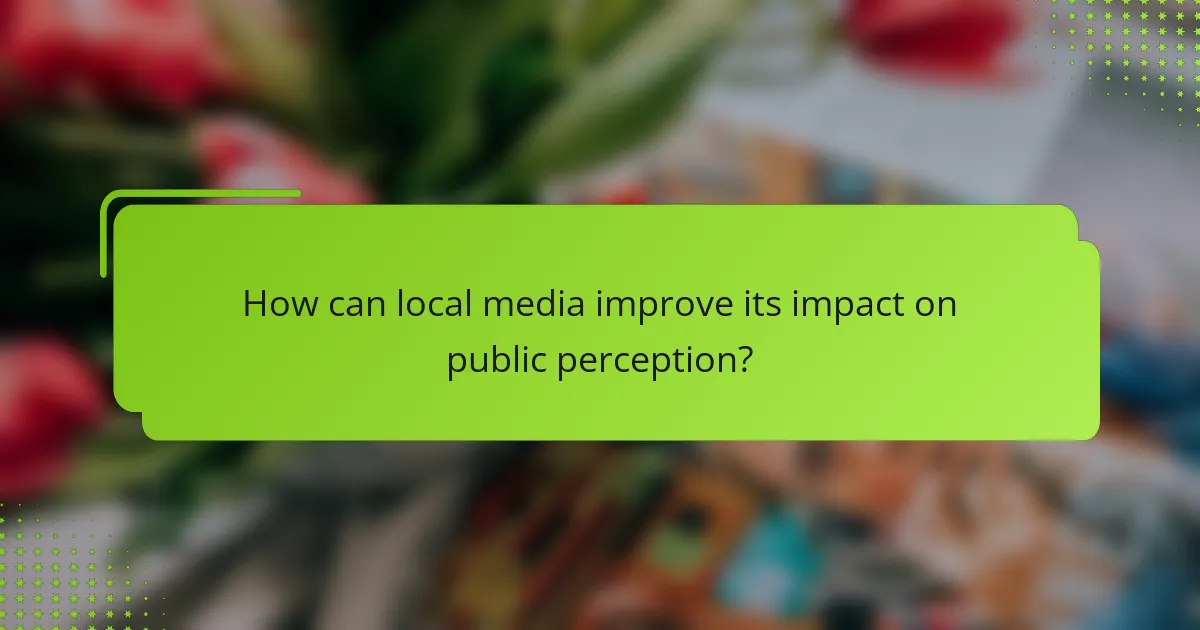
How can local media improve its impact on public perception?
Local media can enhance its influence on public perception by prioritizing accuracy, fairness, and community engagement. By adopting responsible reporting practices and fostering connections with the audience, media outlets can build trust and promote informed discussions.
Strategies for balanced reporting
Balanced reporting involves presenting multiple viewpoints on issues, especially in a diverse society like Bolivia. Media should strive to include voices from various social, economic, and ethnic backgrounds to ensure comprehensive coverage.
Utilizing fact-checking processes and adhering to journalistic standards can significantly improve credibility. Outlets can implement regular training for journalists on ethical reporting and the importance of neutrality to avoid bias.
Engagement with local communities
Engaging with local communities is essential for media to understand the issues that matter most to their audience. This can be achieved through community forums, surveys, and social media interactions, allowing the public to voice their concerns and opinions.
Media organizations should consider partnerships with local NGOs and community leaders to amplify underrepresented voices. This collaboration can lead to more relevant content and foster a sense of ownership among community members regarding the news they consume.

What frameworks exist for analyzing media influence in Bolivia?
Analyzing media influence in Bolivia involves various frameworks that assess how local media shapes public perception and impacts social conflict. These frameworks consider factors such as media literacy, audience engagement, and the methodologies used in research studies.
Media literacy programs
Media literacy programs in Bolivia aim to enhance the public’s ability to critically evaluate media messages. These initiatives often target schools and community organizations, teaching individuals how to discern credible information from misinformation. Effective programs typically include workshops, interactive sessions, and resources that empower participants to engage with media content thoughtfully.
For instance, programs may focus on identifying biases in news reporting or understanding the role of social media in shaping opinions. By fostering critical thinking skills, these initiatives help mitigate the negative effects of sensationalist media and promote informed public discourse.
Research methodologies for media impact studies
Research methodologies for studying media impact in Bolivia include qualitative and quantitative approaches. Qualitative methods often involve interviews and focus groups to gather in-depth insights into audience perceptions, while quantitative methods may utilize surveys to collect data from larger populations. Combining these methods can provide a comprehensive view of media influence.
Key considerations in these studies include the selection of representative samples and the framing of questions to avoid bias. Researchers often analyze content from various media outlets to assess how different narratives affect public opinion, particularly during times of political unrest or social conflict.

What are the challenges faced by local media in Bolivia?
Local media in Bolivia encounter significant challenges that affect their operations and influence on public perception. These challenges include financial sustainability issues and political pressures that can lead to censorship, impacting the ability of media outlets to report freely and effectively.
Financial sustainability issues
Many local media outlets in Bolivia struggle with financial sustainability due to limited advertising revenue and competition from digital platforms. Traditional funding sources, such as local businesses, often prioritize larger media organizations, leaving smaller outlets with inadequate resources.
Moreover, the economic environment can be unstable, which affects the ability of local media to secure consistent funding. To navigate these challenges, local media may consider diversifying revenue streams through subscriptions, crowdfunding, or partnerships with NGOs.
Political pressures and censorship
Political pressures in Bolivia can significantly impact local media, as government entities may exert influence over reporting. This can manifest in direct censorship or through intimidation tactics, discouraging journalists from covering sensitive topics.
Media outlets often face the dilemma of balancing the need for independence with the risk of backlash from political actors. To mitigate these risks, local media should establish clear editorial policies and seek legal support to protect their rights and ensure freedom of expression.
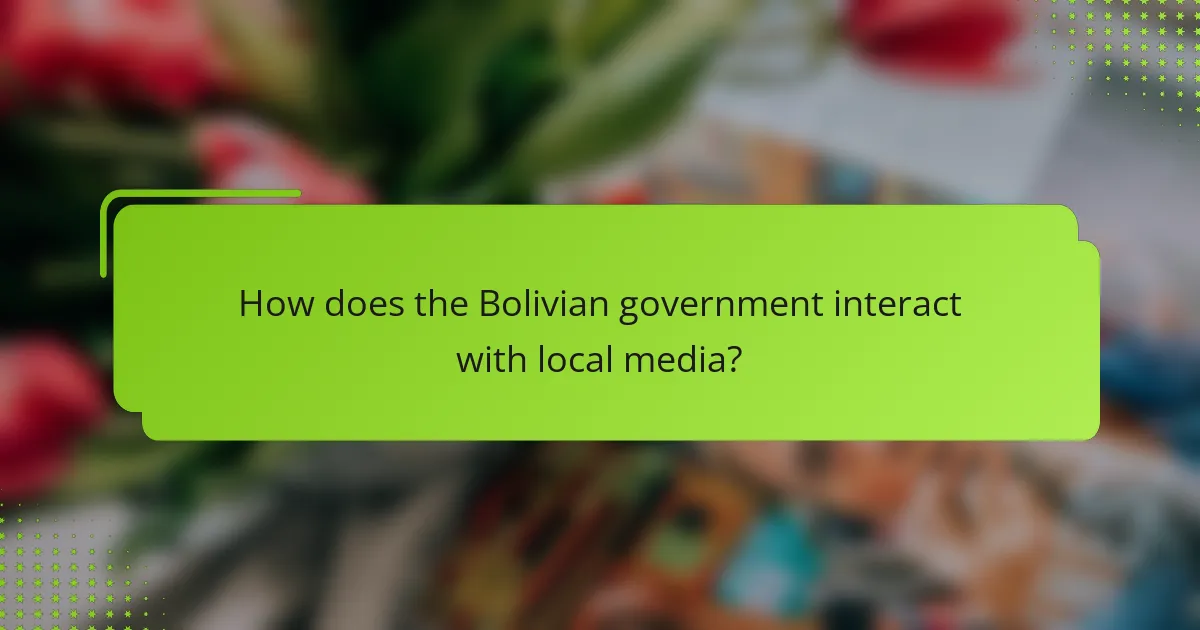
How does the Bolivian government interact with local media?
The Bolivian government engages with local media through a combination of regulatory oversight and support initiatives. This interaction shapes how information is disseminated and influences public perception across the country.
Regulatory frameworks governing media
In Bolivia, media regulation is primarily overseen by the Ministry of Communication, which enforces laws that govern broadcasting and print media. These regulations aim to ensure that media outlets operate within legal boundaries while promoting diversity and pluralism in news coverage.
Key laws include the Law on the Regulation of the Media, which sets standards for content and ownership, and the Law on Audiovisual Communication, which addresses broadcasting rights. Compliance with these frameworks is crucial for media outlets to maintain their licenses and operate effectively.
Government initiatives to support local journalism
The Bolivian government has launched several initiatives to bolster local journalism, recognizing its role in fostering democracy and informed citizenry. Programs may include funding for community radio stations and grants for investigative journalism projects.
Additionally, the government often collaborates with international organizations to provide training and resources for journalists. These efforts aim to enhance the quality of reporting and ensure that local voices are represented in the media landscape.

What emerging trends are shaping local media in Bolivia?
Local media in Bolivia is increasingly influenced by digital transformation and the rise of citizen journalism. These trends are reshaping how news is produced, consumed, and perceived by the public, impacting the overall media landscape.
Digital transformation of news outlets
The digital transformation of news outlets in Bolivia involves the shift from traditional print and broadcast media to online platforms. Many local newspapers and television stations are now prioritizing their digital presence, offering news through websites and social media channels to reach a broader audience.
This transition allows for quicker dissemination of information, but it also presents challenges such as the need for reliable internet access and the risk of misinformation. News outlets must invest in digital tools and training to ensure they can effectively engage with their audience while maintaining journalistic standards.
Rise of citizen journalism
Citizen journalism in Bolivia has gained traction as individuals use smartphones and social media to report news events. This grassroots approach allows for diverse perspectives and immediate coverage of local issues, often filling gaps left by traditional media.
However, while citizen journalism can enhance public discourse, it raises concerns about accuracy and accountability. Media consumers should critically evaluate the sources of information and consider verifying claims through established news outlets to avoid the spread of false narratives.
